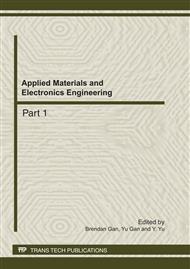p.606
p.610
p.614
p.619
p.623
p.628
p.632
p.636
p.642
Improvement of Mechanical Properties and Transformation Behavior of NiTi Drawn Wires for Orthodontics Applications
Abstract:
NiTi shape memory alloy is widely used in dental applications such as orthodontics arch wire, mini screw implant, orthodontics spring, etc., because of its favorable superelasticity and shape memory effect. Wire drawing is a fundamental manufacturing process used for producing orthodontics arch wires. It is well known that cold-work occurred during wire drawing operation is also important to control mechanical properties and transformation temperature of NiTi wires. Thus, the purpose of this work is to study the effect of cold working by means of reduction ratio of cross -sectional area and heat-treatment temperatures on transformation and mechanical behavior of the drawn wires for utilized as orthodontic wires. The wire material used in this study is Ni51.4Ti48.6 (at%) alloy with various initial diameters with targeted wire diameter of 0.51mm (0.02 inch). The die for wire drawing is made of tungsten carbide which is inserted into a steel case. The dies were designed to have different reduction ratio of cross sectional area for 4 levels; 10%, 20%, 30% and 40%, respectively. The lubricant used in this study is sodium stearate powder. In order to investigate the influences of heat-treatment temperatures, the drawn wires are heat-treated at 400 °C and 600 °C for 3.6ks. The results showed that percentages of reduction of cross sectional area and heat-treatment temperature strongly affect mechanical properties and transformation temperatures. Superelasticity was confirmed in an alloy heat-treated at 400 °C. The results obtained can be used to determine the optimum properties of NiTi wire in order to utilized as orthodontics arch wires.
Info:
Periodical:
Pages:
623-627
Citation:
Online since:
October 2011
Price:
Сopyright:
© 2012 Trans Tech Publications Ltd. All Rights Reserved
Share:
Citation:


